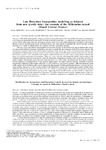Late Hercynian leucogranites modelling as deduced from new gravity data : the example of the Millevaches massif (Massif Central, France)
| dc.contributor.author | Gebelin, A | |
| dc.contributor.author | Martelet, G | |
| dc.contributor.author | Brunel, M | |
| dc.contributor.author | Faure, M | |
| dc.contributor.author | Rossi, P | |
| dc.date.accessioned | 2018-03-07T15:53:04Z | |
| dc.date.available | 2018-03-07T15:53:04Z | |
| dc.date.issued | 2004-05-01 | |
| dc.identifier.issn | 0037-9409 | |
| dc.identifier.issn | 1777-5817 | |
| dc.identifier.uri | http://hdl.handle.net/10026.1/11005 | |
| dc.description.abstract |
<jats:title>Abstract</jats:title> <jats:p>The Millevaches granitic complex, located in the northern part of the French Massif Central, is elongated in a N-S direction, perpendicular to the main E-W trend of the Hercynian belt. It is affected on its limits and in its core by several ductile shear zones that have necessarily played a great role in the emplacement and exhumation of the massif. Based on gravity modelling and recent field observations, this study intends to highlight the massif structure at depth and discuss its mode of emplacement and relations with the surrounding terrains.</jats:p> <jats:p>The new gravity and density measurements on the north-east part of the Millevaches massif improve the gravity coverage of the northern Limousin. Using these new data we model the deep structure of the Millevaches plateau. The density measurements made on the different types of granites of the massif, and on the surrounding terrains improve the interpretation of the Bouguer anomaly. Analysis and inversion of the residual Bouguer anomaly in the area show that the Millevaches massif is 2 to 4 km-thick, from north to south and from west to east, locally rooting down to about 6 km deep in its eastern and southern terminations. These two zones coincide with porphyritic plutons and, because of the complex composite structure of the massif, cannot be definitively interpreted as feeding zones. In the field, the N-S-oriented Pradines vertical fault affects the core of the massif on 4 to 5 km width. Microstructural observations evidence that the faulting is contemporaneous of the granites emplacement. We suggest that this tectonic lineament could have triggered the migration of the magma, although it is not related to a clear gravity anomaly. AMS measurements in the north-central part of the Millevaches massif suggest that the magnetic foliation and lineation display a general sub-horizontal pattern. Moreover, on the western border of the Millevaches massif, the Argentat deep seismic profile shows sub-horizontal layering of gneisses and micaschists and evidences normal faulting offset of this layering along Argentat fault. This agrees fairly well with the gravity results, suggesting that (i) the Millevaches massif would be at a high structural level in the crust, (ii) the exhumation of the massif would have been favoured along the Argentat normal fault. As a whole, the massif can be described as a laccolith, 2 to 4 km-thick, emplaced as a “magmatic lens” into the sub-horizontally foliated gneisses and micaschists.</jats:p> | |
| dc.format.extent | 239-248 | |
| dc.language | en | |
| dc.language.iso | en | |
| dc.publisher | EDP Sciences | |
| dc.subject | 37 Earth Sciences | |
| dc.subject | 3705 Geology | |
| dc.subject | 3706 Geophysics | |
| dc.title | Late Hercynian leucogranites modelling as deduced from new gravity data : the example of the Millevaches massif (Massif Central, France) | |
| dc.type | journal-article | |
| dc.type | Journal Article | |
| plymouth.issue | 3 | |
| plymouth.volume | 175 | |
| plymouth.publication-status | Published | |
| plymouth.journal | Bulletin de la Société Géologique de France | |
| dc.identifier.doi | 10.2113/175.3.239 | |
| plymouth.organisational-group | /Plymouth | |
| plymouth.organisational-group | /Plymouth/Faculty of Science and Engineering | |
| plymouth.organisational-group | /Plymouth/REF 2021 Researchers by UoA | |
| plymouth.organisational-group | /Plymouth/REF 2021 Researchers by UoA/UoA07 Earth Systems and Environmental Sciences | |
| dc.identifier.eissn | 1777-5817 | |
| dc.rights.embargoperiod | Not known | |
| rioxxterms.versionofrecord | 10.2113/175.3.239 | |
| rioxxterms.licenseref.uri | http://www.rioxx.net/licenses/all-rights-reserved | |
| rioxxterms.type | Journal Article/Review |


